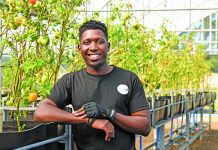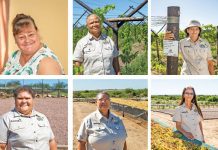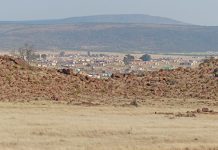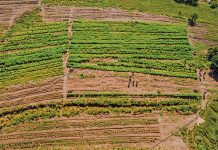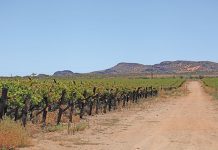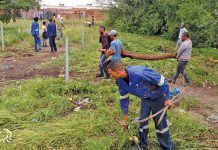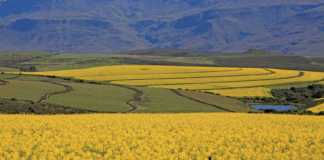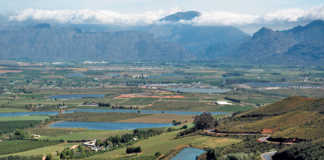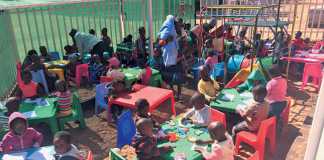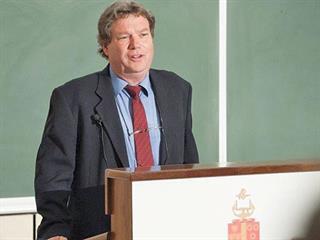
Relaxed, but palpably energetic, Prof Darren Abernethy breezes into the room like a fresh southeaster, perhaps fitting for an ex-pupil of Fish Hoek High School in the Cape Peninsula. After a 27-year absence from South Africa, Abernethy, an epidemiologist by training, returned to the country in May 2012 to take up a post as head of Onderstepoort’s department of tropical diseases. Then in August 2014, Abernethy took office as the new Dean of the Faculty of Veterinary Science.
“I was attracted to the position here because it involved training courses in Africa for which I have a passion,” he explains.
The Faculty of Veterinary Science of the University of Pretoria is situated on the Onderstepoort campus of the university north of Pretoria. Quizzed about rumours of a drop in standards at South Africa’s only vet school, Abernethy gave an emphatic response: “In the international arena, Onderstepoort’s first-rate reputation is still intact,” he says.
Soon after his arrival at the faculty, the routine five-yearly accreditation visit was conducted by a panel of experts from various international veterinary boards, including the UK’s Royal Vet College. The review board gave the school a good rating, with some recommendations for follow-up, but no issues of significant concern.
He points out that a key advantage for Onderstepoort graduates is the 18 months of experiential clinical training they have by the time they reach the end of the programme.
“European programmes have a higher theoretical component, but very little practical exposure,” says Abernethy. “And there are certainly vet practices in the UK that will try and find a South African graduate before looking elsewhere.”
Training
Abernethy’s tenure as dean coincides with the start (from 2016) of a year’s compulsory community service for graduate vets.
“This is an enlightened move on government’s part that should prove an enormous help to small- and medium-scale stock farmers and improve disease control in the rural areas,” he says.
Staying relevant means that the faculty must be sensitive to the needs of government. In a changing environment, Onderstepoort should strive to produce vets with all-round capabilities who are equally at home consulting to small-scale stock farmers, wildlife ranchers, large herd farmers and the urban pet owner, says Abernethy.
Traditionally, the course has been geared towards training for large and small animals (mixed practice) with a rather stronger leaning towards small animal practice. The reason for this weighting is that advances in animal medicine tend to follow advances in human medicine.
“So you’ll get vets treating disc prolapses in dogs, things like hip replacement surgery and hi-tech prosthetics. These are procedures that use super-expensive equipment and need super-skilled personnel,” he explains. Abernethy points out, however, that it is the practical animal approach that farmers need and are prepared to pay for. And it is here that the agriculture department sees a gap as there are not enough vets available to work in rural areas.
The faculty of course cannot dictate to graduates where and in what field they should work, he says, but it is in everyone’s interests that the outcome is balanced and that graduates are competent to serve the agricultural sector, particularly the small-scale farmer.
Onderstepoort has a competency list agreed on with the South African Vet Council, which it makes available to government, but Abernethy feels that greater emphasis must be made for real delivery to small-scale farmers. With annual graduate numbers of about 190 vets, the community service year will significantly help to close the gap and bring vets closer to rural communities.
Research is crucial
As a research epidemiologist, Abernethy has spent most of his professional career working with diseases of relevance to the SA government, specialising in bovine TB (bTB) and brucellosis (CA). “Northern Ireland, where I worked, was the last country in northern Europe to have brucellosis,” he says.
His arrival in South Africa could not have been better timed, with major problems in these two diseases surfacing in herds countrywide.
“As with our training, we want to make sure the research we do is relevant to the department [of agriculture]. As a faculty we have been accused of not being sufficiently aligned to the country’s needs, and, while I am not convinced of the absolute truth of this accusation, I understand how it came about,” he says.
Research is expensive and funders will logically be more inclined to put their money into institutions with competence and capacity, and into researchers with solid reputations. These academics are expected to have a proven background of relevant research, while at the same time lecturing, building networks and marketing the school or field of study, before donors will bring money to the research table.
Abernethy says he has been fortunate to find funding for a brucellosis programme.
“We have three internationally recognised scientists presenting at an upcoming brucella workshop, and industry stakeholders like the large animal labs, the pharmaceutical companies and government are involved,” he says.
Abernethy describes this as an explicit attempt to discover research needs and follow up with relevant research, which he sees as a core function of the faculty. Interestingly, a multi-disciplinary approach to research is emerging in various fields as innovative scientists realise the value of integrating inputs to find workable solutions.
This is evident in the Mnisi project, set up by the faculty near the Kruger National Park (KNP)’s Orpen gate. The Mnisi community is in a recognised poverty node alongside the KNP, along with many other communities that were moved out of the national park in the past.
“Looking at poverty alleviation, we’ve put together research teams in which vets work with, for example, social scientists, economists and agronomists. The quality of research is hugely improved.”
Areas where livestock, wildlife and people constantly interact are places “where things get interesting” says the dean.
Researchers from various international communities are keen to conduct research and work in South Africa. This has powerful advantages: positive spinoffs for global collaboration, ready access to top international scientists, an added incentive for funders, and a higher profile for the faculty.
Diseases & vaccines
A fundamental problem in disease control is that vaccines only protect to a certain extent, and vaccination programmes are voluntary, with no obligations on stock owners, except to inform the state where there is a notifiable disease outbreak. Moreover, the resources needed to drive vaccination programmes seem to be lacking, and livestock trading means that animal movement is largely unrestricted. Detection of brucellosis, for example, is fairly easy to avoid.
While Abernethy agrees that a comprehensive vaccination programme would improve the situation, flaws in vaccine administration and breakdown of the vaccine cold chain would still need attention. “We assume that small-scale farmers are buying from the commercial sector, but don’t really know what controls are in place at auctions, because of a lack of traceability. Ignorance alone is sufficient to allow for the wildfire spread of a disease like brucella and it’s the same with bTB.
Once the infectious disease reaches a certain level, countrywide, it seems to create a platform from which it starts spiking.”
Bovine tuberculosis is another problematic disease in SA, with some outbreaks thought not to be reported and a lack of consistent testing. There is no commercial vaccine currently available for bTB, says the dean.
“In the EU, the emphasis is on trying to develop vaccines for wildlife, but that could be a problem here, with buffalo the most common reservoir host for bTB,” he says. Reservoir hosts are usually symptom-free, but they ‘shed’ the virus, which then affects susceptible spill-over hosts such as cattle, says Abernethy.
“Bovine TB tends to be host-specific, affecting bovines only. In 20 years in [Northern] Ireland, I can’t recall a single case of a farmer affected by a cross-infection. Unfortunately, this isn’t the case with brucella – if it’s in the herd, you often find the farmer is positive.”
Vets of the future
Abernethy feels that digital technology will advance to the point where immediate on-farm and cow-side diagnoses may be possible. A different approach to teaching is also evolving, with blended learning appearing. This works well for vets as it teaches students how to problem-solve through case studies.
“There’s no denying the importance of basic academic discipline, but I think we’ve ignored for too long the equal importance of knowing how to access information and use available tools,” he stresses. Because Onderstepoort is the only veterinary faculty in the country, it is possible, says Abernethy, for some ‘cocooning’ to take place.
“There are no other faculty for us to benchmark against, as there is in the medical field, so I’m in favour of another vet school opening. It may mean some competition for us but it will help to get more vets out into the field.”
To make sure that graduates have the training to meet the requirements needed, interaction with government, industry and farmers, large and small, is critical, he says. “I believe Africa needs more vets, and my vision is to keep producing world- class graduates, while I’m committed to producing well-rounded vets who attain the relevance needed in a changing society.”
Email Chris van Blerk at [email protected].

